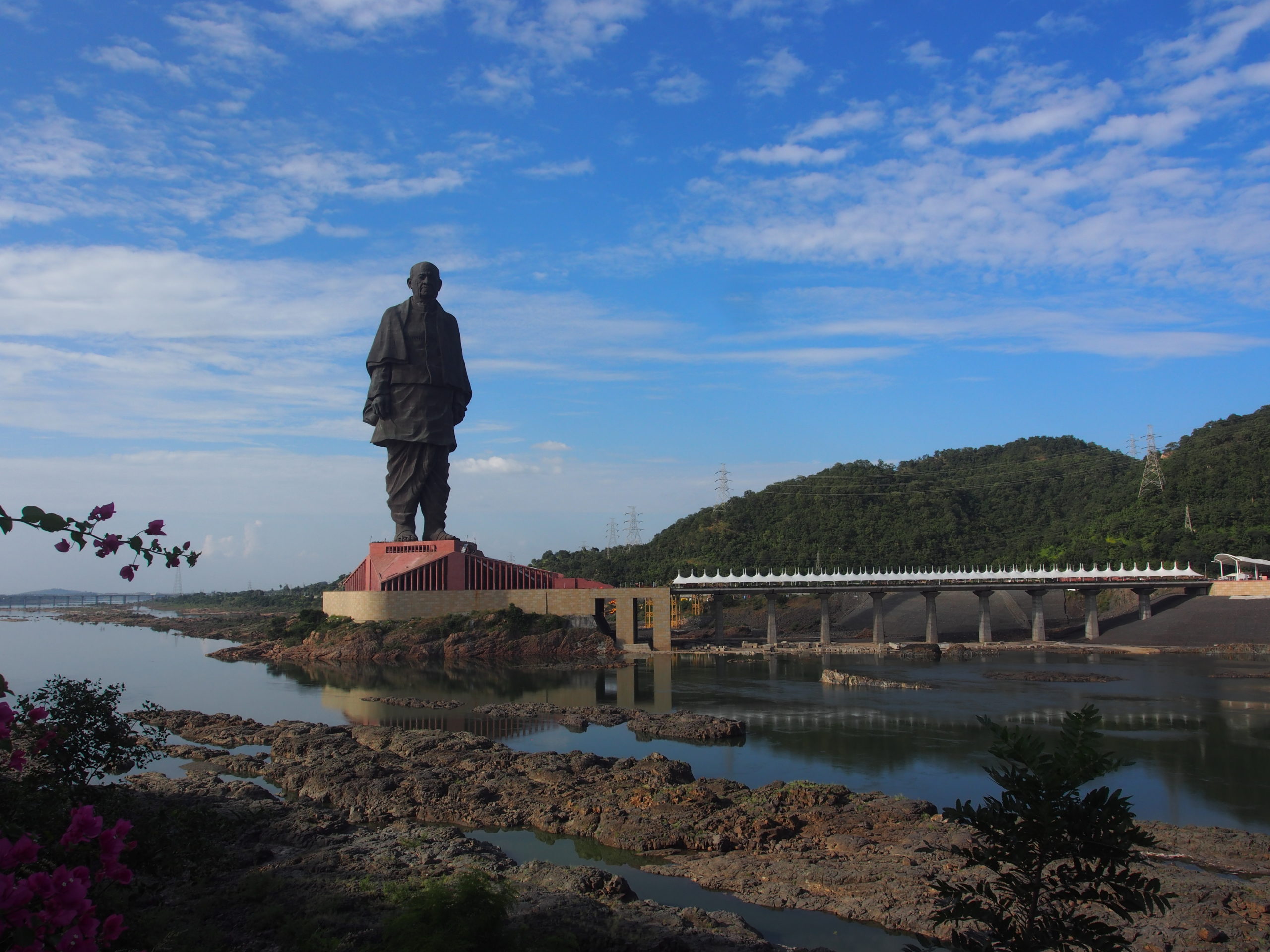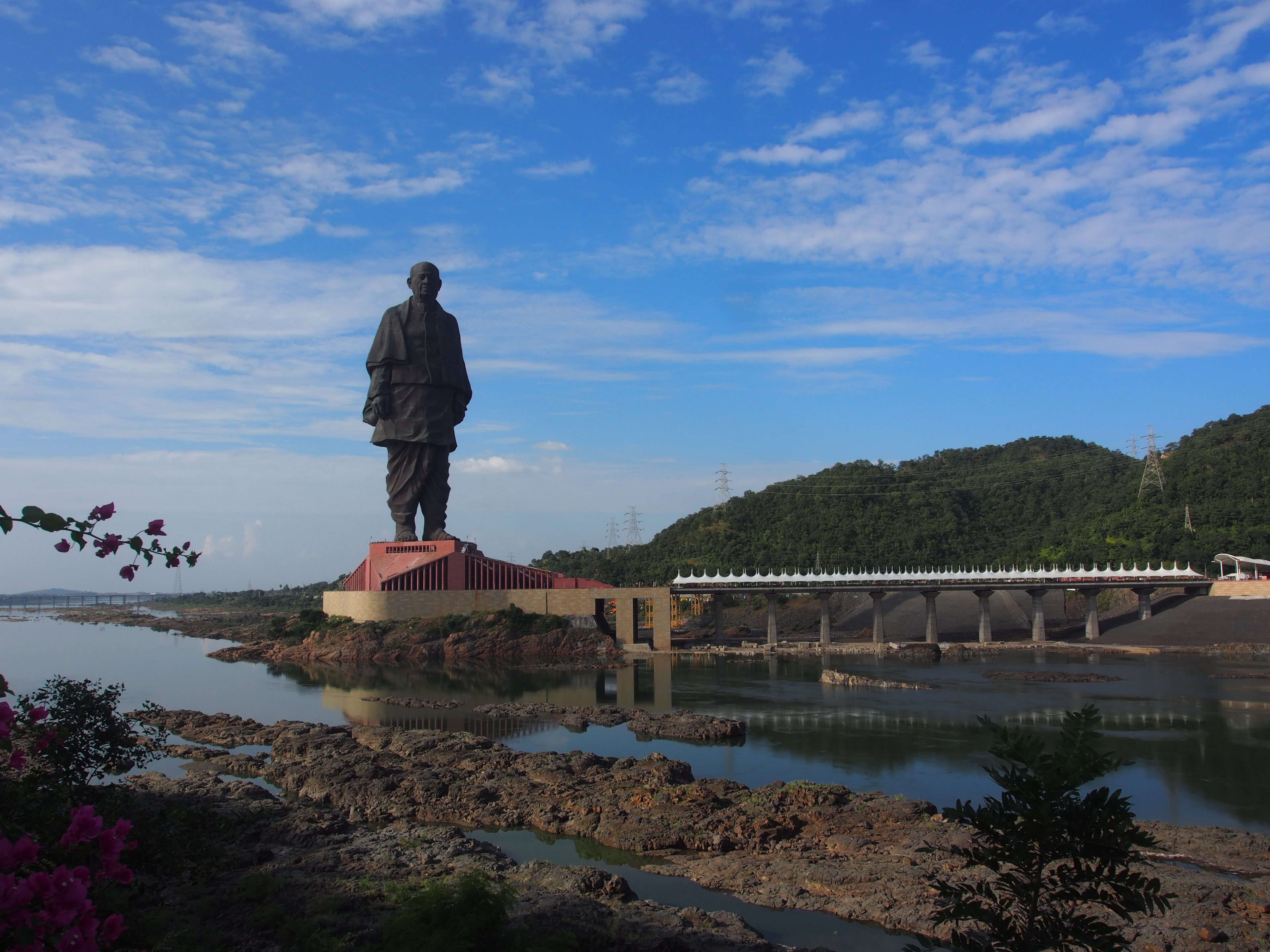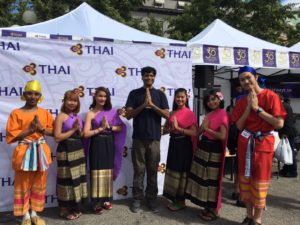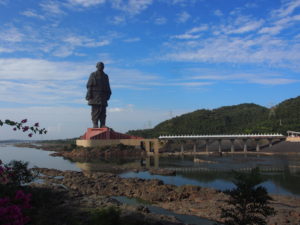
The Statue of Unity is a colossal statue of Indian statesman and independence activist Sardar Vallabhbhai Patel (1875–1950), who was the first Deputy Prime Minister and Home minister of independent India and the chief adherent of Mahatma Gandhi during the non-violent Indian Independence movement

182 M HEIGHT FROM TOP OF BASE
240 M INCLUDING BASE
STATUE OF UNITY : SPECTACULAR VIEWS FROM ABOVE
182 M HEIGHT FROM TOP OF BASE
240 M INCLUDING BASE
182 M HEIGHT FROM TOP OF BASE
240 M INCLUDING BASE
182 M HEIGHT FROM TOP OF BASE
240 M INCLUDING BASE
STATUE OF UNITY : VIEWS FROM
´´THE HEART OF SARDAR VALLABHBHAI PATEL´´
VIEWS FROM TOP OF THE STATUE AT 153 METRE HEIGHT
182 M HEIGHT FROM TOP OF BASE
240 M INCLUDING BASE
VIEWS FROM THE ´´HEART OF SARDAR VALLABHBHAI PATEL´´
VIEWS FROM TOP OF THE STATUE AT 153 METRE HEIGHT
VIEWS LOOK DOWN INTO NARMADA RIVER, THE SORROUNDING MOUNTAINS AS WELL AS THE SARDAR SAROVAR DAM
182 M HEIGHT FROM TOP OF BASE
240 M INCLUDING BASE
VIEWS FROM THE ´´HEART OF SARDAR VALLABHBHAI PATEL´´
VIEWS FROM TOP OF THE STATUE AT 153 METRE HEIGHT
VIEWS LOOK DOWN INTO NARMADA RIVER, THE SORROUNDING MOUNTAINS AS WELL AS THE SARDAR SAROVAR DAM
STATUE OF UNITY : EXTERNAL VIEWS TOWARDS THE STATUE
182 M HEIGHT FROM TOP OF BASE
240 M INCLUDING BASE
182 M HEIGHT FROM TOP OF BASE
240 M INCLUDING BASE
182 M HEIGHT FROM TOP OF BASE
240 M INCLUDING BASE
182 M HEIGHT FROM TOP OF BASE
240 M INCLUDING BASE
182 M HEIGHT FROM TOP OF BASE
240 M INCLUDING BASE
182 M HEIGHT FROM TOP OF BASE
240 M INCLUDING BASE
SOUVENIR SHOP
182 M HEIGHT FROM TOP OF BASE
240 M INCLUDING BASE
182 M HEIGHT FROM TOP OF BASE
240 M INCLUDING BASE
182 M HEIGHT FROM TOP OF BASE
240 M INCLUDING BASE
STATUE OF UNITY
VIEWS AROUND THE STATUE AREA
182 M HEIGHT FROM TOP OF BASE
240 M INCLUDING BASE
VIEWS OF NARMADA RIVER FLOWING BESUDE THE STATUE
182 M HEIGHT FROM TOP OF BASE
240 M INCLUDING BASE
VIEWS OF THE PARK AND THE NARMADA RIVER FLOWING BESIDE THE STATUE
182 M HEIGHT FROM TOP OF BASE
240 M INCLUDING BASE
VIEWS OF THE PARK AND THE NARMADA RIVER FLOWING BESIDE THE STATUE
182 M HEIGHT FROM TOP OF BASE
240 M INCLUDING BASE
VIEWS OF THE PARK AND THE NARMADA RIVER FLOWING BESIDE THE STATUE
182 M HEIGHT FROM TOP OF BASE
240 M INCLUDING BASE
VIEWS OF THE NARMADA RIVER FLOWING BESIDE THE STATUE
What is the Statue of Unity ?
- The Statue of Unity is a colossal statue of Indian statesman and independence activist Sardar Vallabhbhai Patel (1875–1950), who was the first Deputy Prime Minister and Home minister of independent India and the chief adherent of Mahatma Gandhi during the non-violent Indian Independence movement
- It is the world’s tallest statue with a height of 182 metres
- Patel was highly respected for his leadership in uniting the 552 princely states of India to form the single Union of India
- It is located in the state of Gujarat, India. It is located on a river facing the Sardar Sarovar Dam on river Narmada in Kevadiya colony, 100 kilometres (62 mi) southeast of the city of Vadodara and 150 kilometres (93 mi) from Surat
- The project was first announced in 2010 and the construction of the statue started in October 2013 by Larsen & Toubro
- It was designed by Indian sculptor Ram V. Sutar, and was inaugurated by Indian Prime Minister Narendra Modi on 31 October 2018, the 143rd birth anniversary of Patel
What is the history behind the Statue of Unity ?
- Narendra Modi first announced the project to commemorate Vallabhbhai Patel on 7 October 2013 at a press conference to mark the beginning of his 10th year as The Chief Minister of Gujarat
- At the time, the project was dubbed, “Gujarat’s tribute to the nation”
- A separate Society named Sardar Vallabhbhai Patel Rashtriya Ekta Trust (SVPRET) has been formed under the Chairmanship of Chief Minister, Government of Gujarat, to ensure seamless execution of the entire project
- An outreach drive named the Statue of Unity Movement was started to support the construction of the statue
- It helped collect the iron needed for the statue by asking farmers to donate their used farming instruments
- By 2016, total 135 metric tonnes of scrap iron had been collected and about 109 tonnes of it was used to make the foundation of the statue after processing
- A marathon entitled Run For Unity was held on 15 December 2013 in Surat and in Vadodara in support of the project
What is the Design & Construction background behind the Statue of Unity ?
- The statue depicts Vallabhbhai Patel, one of the most prominent leaders of the Indian independence movement, the first Deputy Prime Minister of India, and responsible for the integration of hundreds of princely states into the modern Republic of India
- The Statue of Unity is an enlarged version of this statue in the Ahmedabad International Airport
- After studying numerous statues of Patel across the country, a team of historians, artists, and academics chose to proceed with a design submitted by the Indian sculptor, Ram V. Sutar
- The Statue of Unity is a much larger replica of a statue of the leader installed at Ahmedabad International Airport
- Commenting on the design, Ram Sutar‘s son, Anil Sutar, explains that “the expression, posture and pose justify the dignity, confidence, iron will as well as kindness that his personality exudes
- The head is up, a shawl flung from shoulders and hands are on the side as if he is set to walk”
- Three models of the design measuring 3 feet (0.91 m), 18 feet (5.5 m), and 30 feet (9.1 m) were initially created
- Once the design of the largest model was approved, a detailed 3D-scan was produced which formed the basis for the bronze cladding cast in a foundry in China
- Patel’s dhoti-clad legs and the use of sandals for footwear rendered the design thinner at the base than at the top thereby affecting its stability
- This was addressed by maintaining a slenderness ratio of 16:19 rather than the customary 8:14 ratio of other tall buildings
- The statue is built to withstand winds of up to 180 kilometres per hour (110 mph) and earthquakes measuring 6.5 on the Richter scale which are at a depth of 10 km and within a radius of 12 km of the statue
- This is aided by the use of two 250-tonne tuned mass dampers which ensure maximum stability
- The total height of the structure is 240 m (790 ft), with a base of 58 m (190 ft) and statue of 182 m (597 ft)
- The height of 182 was specifically chosen to match the number of seats in the Gujarat Legislative Assembly
Why was the number 182 chosen specifically as the height of the Statue of Unity ?
The height of 182 was specifically chosen to match the number of seats in the Gujarat Legislative Assembly
How was the funding ?
- The statue was built by Public Private Partnership model, with most of the money raised by the Government of Gujarat
- The Gujarat state government had allotted ₹500 crore (equivalent to ₹564 crore or US$82 million in 2018) for the project in the budget from 2012 to 2015
- In the 2014–15 Union Budget, ₹200 crore (equivalent to ₹239 crore or US$35 million in 2018) were allocated for the construction of the statue
- Funds were also contributed by Public Sector Undertakings under Corporate Social Responsibility scheme
How was the construction ?

The statue under construction in January 2018

Approximate heights of various notable statues :
- Statue of Unity 240 m (incl. 58 m base)
- Spring Temple Buddha 153 m (incl. 25 m pedestal and 20 m throne)
- Statue of Liberty 93 m (incl. 47 m pedestal)
- The Motherland Calls 87 m (incl. 2 m pedestal)
- Christ the Redeemer 38 m (incl. 8 m pedestal)
- Michelangelo’s David 5.17 m (excl. 2.5m plinth)
- A consortium comprising Turner Construction, Michael Graves and Associates and the Meinhardt Group supervised the project
- It took 57 months to complete – 15 months for planning, 40 months for construction and two months for handing over by the consortium
- The total cost of the project was estimated to be about ₹ 2063 crore (equivalent to ₹ 25 billion or US$ 360 million in 2018) by the government
- The tender bids for the first phase were invited in October 2013 and were closed in November 2013
- Narendra Modi, then serving as Chief Minister of Gujarat, laid the statue’s foundation stone on 31 October 2013, the 138th anniversary of Patel’s birth
- Indian infrastructure company Larsen & Toubro won the contract on 27 October 2014 for its lowest bid of ₹2989 crore (equivalent to ₹36 billion or US$520 million in 2018) for the design, construction and maintenance
- They commenced the construction on 31 October 2014
- In the first phase of the project, ₹1347 crore were for the main statue, ₹235 crore for the exhibition hall and convention centre, ₹83 crore for the bridge connecting the memorial to the mainland and ₹657 crore for the maintenance of the structure for 15 years after its completion
- The Sadhu Bet hillock was flattened from 70 to 55 metres to lay the foundation
- L&T employed over 3000 workers and 250 engineers in the statue’s construction
- The core of the statue used 210000 cubic metres (7400000 cu ft) of cement concrete, 6500 tonnes of structural steel, and 18500 tonnes of reinforced steel
- The outer façade is made up of 1700 tonnes of bronze plates and 1850 tonnes of bronze cladding which in turn comprise 565 macro and 6000 micro panels
- The bronze panels were cast in Jiangxi Tongqing Metal Handicrafts Co. Ltd (the TQ Art foundry) in China as suitable facilities were unavailable in India
- The bronze panels were transported over sea and then by road to the workshop near the construction site where they were assembled
- Local tribals belonging to the Tadvi tribe opposed land acquisition for the development of tourism infrastructure around the statue
- They have been offered cash and land compensation, and have been provided jobs
- People of Kevadia, Kothi, Waghodia, Limbdi, Navagam, and Gora villages opposed the construction of the statue and demanded the restitution of the land rights over 375 hectares (927 acres) of land acquired earlier for the dam as well as the formation of new Garudeshwar subdistrict
- They also opposed the formation of Kevadia Area Development Authority (KADA) and the construction of Garudeshwar weir-cum-causeway project. The government of Gujarat accepted their demands
- Construction of the monument was completed in mid-October 2018; and the inaugural ceremony was held on 31 October 2018, presided over by Prime Minister Narendra Modi
- The statue has been described as a tribute to Indian engineering skills
What are the salient features of the Statue of Unity ?
- The Statue of Unity is the world’s tallest statue at 182 metres (597 ft)
- It rises 54 metres (177 ft) higher than the previous record holder, the Spring Temple Buddha in China’s Henan province
- The previous tallest statue in India was the 41 m (135 ft) statue of Hanuman at the Paritala Anjaneya Temple near Vijayawada in the state of Andhra Pradesh
- The statue can be seen within a 7 km (4.3 mi) radius
- The monument is constructed on a river island named Sadhu Bet, 3.2 km (2.0 mi) away from and facing the Narmada Dam downstream
- The statue and its surroundings occupy more than 2 hectares (4.9 acres) and are surrounded by a 12 km (7.5 mi) long artificial lake formed by the Garudeshwar weir downstream on the Narmada river
- The statue is divided into five zones of which only three are accessible to the public
- From its base to the level of Patel’s shins is the first zone which has three levels and includes an exhibition area, mezzanine and roof
- Zone 1 – contains a memorial garden and a museum
- Zone 2 – The second zone reaches up to Patel’s thighs
- Zone 3 – The third extends up to the viewing gallery at 153 metres
- Zone 4 – is the maintenance area while
- Zone 5 – The final zone comprises the head and shoulders of the statue
- The museum in zone 1 catalogues the life of Sardar Patel and his contributions
- An adjoining audio-visual gallery provides a 15-minute presentation on Patel and also describes the tribal culture of the state
- The concrete towers which form the statue’s legs contain two elevators each. Each lift can carry 26 people at a time to the viewing gallery in just over 30 seconds
- The gallery is located at a height of 153 metres (502 ft) and can hold up to 200 people

